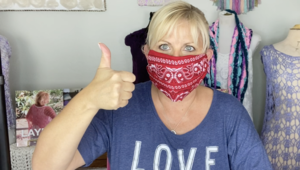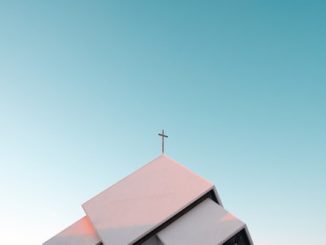
San Francisco, CA, USA – Now that the US Center for Disease Control (CDC) asks that we all wear a protective face mask covering nose and mouth when we leave our homes, the mad scramble to find masks has begun. And while there is general agreement that those on the front lines of this battle against the novel coronavirus and its deadly severe acute respiratory syndrome COVID-19 need the scarce N95-rated protective masks, it’s gotten harder to find even the skimpier mask versions.
NEW FINDINGS UNDERSCORE THE IMPORTANCE OF PROTECTIVE MASKS- IN ADDITION TO SOCIAL DISTANCING
At the beginning of the novel coronavirus pandemic, we were told to “mask up” only if we were exhibiting symptoms of being sick so that we wouldn’t make others around us sick. However, what’s been discovered, according to the CDC, is that many of us exposed to the novel coronavirus are symptom-free; we would never have considered a need for wearing a protective mask. Any of us might then very easily “carry” the virus to everyone and anyone around us, potentially infecting as many people as we might come in contact with.
Addtionally, any of us “sick with” COVID-19 and who are what the CDC terms “pre-symptomatic,” can also transmit the virus. So it becomes the case that anyone- whether appearing sickly or not- who speaks, coughs, or sneezes closely to another individual could cause that person to become infected with the novel corona virus. There is also a debate about whether or not (and/or how long) the novel coronavirus can be “aerosolized” vs “dropletted” into the air, which would greatly increase the need for masks worn to protect not only from virus product that might be put upon or near to a person, but also that virus product hanging around in the air that one might walk through and inhale…
So, in addition to maintaining the Social Distancing to which, hopefully, we’re now all accustomed, anyone leaving their Shelter-In-Place status for a “necessary” trip outside where Social Distancing will be difficult to maintain, say a run to the pharmacy or grocery store, must have something on their face- N95, surgical, or cloth. The objective: slow the spread of the novel coronavirus and keep down to as low a number as possible the number of infected persons needing hospital care. Haveing everyone- vs. just some persons- wearing a mask, as the CDC recommends, has recently been shown to be highly effective in mitigating spread of the novel coronavirus in other countries. It is the hope that everyone wearing a mask can now have a dramatic impact upon mitigating virus spread right now, here in the US.
MASK SCARCITY IS MOTHER OF CREATIVE INVENTION
With protective face masks in short supply, Americans are stepping up, taking initiative and demonstrating the ingenuity of our DIY culture. The internet is buzzing with crafting spokespersons who have easy-to-follow video instructions for making No-Sew protective masks from cotton squares and other materials one might have lying around the house. The newest member of the PBS “Knit and Crochet Now!” show, Kristin Omdahl offers a simple-fold model, made from a bandana and two rubber bands here: https://www.youtube.com/watch?v=1r2C1zGUHbU.

Other No-Sew suggestions include three on-the-fly face masks offered by “prepper” Malcolm Lawson at his Youtube channel Survival Know How. His April 3, 2020 Youtube video includes a protective mask made from a paper towel, two rubber bands, and staples; a mask made from a cotton t-shirt; and a washable mask made from a bandana and two rubber bands. See here:
How to make three different easy No-Sew cloth protective face masks
In his most recent Youtube video, April 6, 2020, Lawson confirms the specific CDC requirement for those of us not on the front lines: “The CDC recommends wearing face cloth coverings in public settings where other social distancing measures are difficult to maintain (e.g., grocery stores and pharmacies.)” Lawson has tested and offers us a look at the DIY masks the CDC offers on its site- both pros and cons: https://www.youtube.com/watch?v=EfB6DgxnDaM

Riley Blake Designs provides a (very pretty!) sewn version of protective mask that is a kind of “hybrid,” with a filter pocket, here: https://www.youtube.com/watch?v=3YXQ0Y1NxdY. Their designer, Cindy Cloward, also offers tips regarding choosing the best quality cotton.
Not creative one bit? Looking for something as you run out the door? Here’s a super-easy and super stay-in-place version made with a short-sleeved t shirt and a pair of scissors: https://www.youtube.com/watch?v=OvU66B4ENH8&feature=youtu.be. Just be mindful of the fabric you choose. New data is coming in, seemingly daily, regarding filtration efficiency of various fiber content ratios.
Volunteer groups are making “stepped-up” versions of the simpler masks for themselves, their families, and to give away to front liners- augmented with various types of filters inserted into pockets. These, of course, need a word of caution here: any homemade masks to be made for and given to front liners must conform to certain filtration specs. See CDC guidelines, also see the Olson mask, designed by hospital staff, here: https://www.youtube.com/watch?v=ZnVk12sFRkY.

With all hands on deck in our joint efforts to increase production of protective masks, even an online vacuum cleaner sales group (evacuumstore.com) has provided a proposed form of protective mask. Made with HEPA vacuum cleaner bags, their design is, admittedly, not as “fashion friendly” as those proposed above. However, the group does offer some interesting filtration efficiency testing results.
CDC ON HOW TO PROPERLY USE A PROTECTIVE FACE MASK:
Once you’ve got your protective face mask made, you want to be sure to wear it correctly. The CDC reminds that “face coverings should—
- fit snugly but comfortably against the side of the face
- be secured with ties or ear loops
- include multiple layers of fabric
- allow for breathing without restriction
- be able to be laundered and machine dried without damage or change to shape.”*
If you’d like to make simple protective face masks for yourself, your family, and friends to wear when out of the house, you’ve got some good starter ideas right here. Some of these designs can be run up in a matter of minutes.
If you’d like to join the effort to help supply our frontliners, please stay tuned for my next article.
Stay safe and healthy!
*Text taken from the U.S. Center for Disease Control (CDC) web site




Thanks for sharing wonderful information.
It’s great to have all of this information about face masks in one place!
Thanks, Erin. I’m going to be focusing on masks for “front liners,” next, and soon after showcase what some amazing DIY volunteer crafty folk are doing in support of those “front liners.” Stay tuned! And stay healthy and safe!